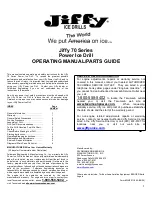
9 - English
OPERATION
WARNING:
Do not allow familiarity with products to make you
careless. Remember that a careless fraction of a
second is sufficient to inflict severe injury.
WARNING:
Always wear eye protection with side shields
marked to comply with ANSI Z87.1. Failure to do
so could result in objects being thrown into your
eyes, resulting in possible serious injury.
APPLICATIONS
You may use the product for the purposes listed below:
Drilling in wood
Drilling in both hard and soft metals
Mixing paints and drywall compounds (
See Figure 8)
SWITCH TRIGGER
See Figure 4, page 13.
To turn the drill
ON
, depress the switch trigger. Release the
switch trigger to turn the drill
OFF
.
VARIABLE SPEED
The variable speed switch delivers higher speed with in-
creased trigger pressure and lower speed with decreased
trigger pressure.
NOTE:
You might hear a whistling or ringing noise from the
switch during use. Do not be concerned; this is a normal
part of the switch function.
DIRECTION OF ROTATION SELECTOR
(FORWARD/REVERSE)
See Figure 5, page 13.
The direction of bit rotation is reversible and is controlled
by a selector located above the switch trigger. With the drill
held in normal operating position, the direction of rotation
selector should be positioned to the left of the switch trigger
for forward drilling. The drilling direction is reversed when
the selector is to the right of the switch trigger.
CAUTION:
To prevent gear damage, always allow the chuck
to come to a complete stop before changing the
direction of rotation.
To stop the drill, release the switch trigger and allow the
chuck to come to a complete stop.
NOTE:
The drill will not run unless the direction of rotation
selector is pushed fully to the left or right.
Avoid running the drill at low speeds for extended periods
of time. Running at low speeds under constant usage may
cause the drill to become overheated. If this occurs, cool
the drill by running it without a load and at full speed.
TO INSTALL BITS
.
See Figures 6 - 7, page 13
Unplug the drill.
Insert the chuck key and twist counterclockwise.
Insert the drill bit into the chuck the full length of the jaws.
WARNING:
Make sure to insert the drill bit straight into the
chuck jaws. Do not insert the drill bit into the chuck
jaws at an angle then tighten, as shown in figure 7.
This could cause the drill bit to be thrown from the
drill, resulting in possible serious personal injury or
damage to the chuck.
Tighten the chuck jaws securely on the drill bit, using the
chuck key provided. Do not use a wrench to tighten or
loosen the chuck jaws. For best performance, repeat this
for the remaining two key holes.
Remove the chuck key and return it to the storage area.
TO REMOVE BITS
Unplug the drill.
Loosen the chuck jaws using the chuck key provided.
Remove the drill bit from the chuck jaws.
Remove the chuck key and return it to the storage area.
CHUCk kEY
A chuck key has been provided for use when installing or
removing bits. It is also used when removing the chuck.
When not in use, the chuck key can be placed in the key
strap.
LOCk-ON BUTTON
This drill is equipped with a lock-on feature, which is
convenient for continuous drilling for extended periods of
time.
To lock-on:
Depress the switch trigger.
Push in and hold the lock-on button, located on the side
of the handle.
Release the switch trigger.
Release the lock-on button and the drill will continue
running.
To release the lock, depress and release the switch
trigger.
If the lock-on feature is engaged during use and the drill
becomes disconnected from the power supply, disengage
the lock-on feature immediately.
Содержание R71211
Страница 35: ...15 NOTES NOTAS...










































